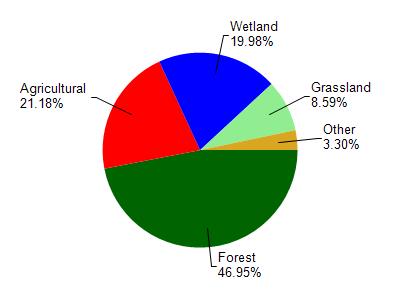Waushara
No
No
No
Fish and Aquatic Life
Overview
Marl Lake, in the White River Watershed, is a 27.61 acre lake that falls in Waushara County. This lake is managed for fishing and swimming and is currently not considered impaired.
Date 2011
Author Aquatic Biologist
Historical Description
Source: 1970, Surface Water Resources of Waushara County
Marl Lake T-19-N, R-9-E, Section 23
Surface Acres = 40.6; S.D.F. = 1.68; Maximum Depth = 34 feet
This lake is essentially landlocked, having an intermittent
inlet which enters in the northwest corner. There is no outlet.
The primary water source is from seepage. The lake develops a
midsummer thermocline at 20 feet. The littoral bottom zone is
extensive along the north and southeast shore, becoming quite
restrictive along the southern portion of the lake. Marl is the
principle bottom material in this shallow water zone. This lake
was chemically treated in 1960 to eradicate a slow-growing
panfish population. The lake was subsequently restocked and
managed for largemouth bass and trout, successfully until 1965.
Unauthorized stocking of panfish and northern pike after the
treatment has degraded the lake's ability to accommodate and grow
stocked trout. As a result of this activity the lake is no
longer stocked with trout, and is now considered and managed for
warm water fishing only. The present fishery includes northern
pike, perch, largemouth bass, and bluegills. Approximately ten
acres of shallow marsh adjoins the lake to provide habitat for
some waterfowl. The Township of Deerfield maintains an excellent
access on township owned lands on the north side of the lake.
The access has an adequate parking area and picnic and swimming
facilities. Because of its small size, motor boats are not
necessary to enjoy the fishing and recreational opportunities
afforded by this lake. Water level fluctuations may be a use
problem.
Date 1970
Author Surface Water Inventory Of Wisconsin
General Condition
Marl Lake (105800) was assessed during the 2016 listing cycle; total phosphorus and chlorophyll sample data were clearly below 2016 WisCALM listing thresholds for the Recreation use and Fish and Aquatic Life use. This water was also assessed for chlorides and sample data were clearly below 2016 WisCALM chronic and acute listing criteria for the Fish and Aquatic Life use. This water is meeting these designated uses and is not considered impaired.
Date 2015
Author Ashley Beranek
Condition
Wisconsin has over 84,000 miles of streams, 15,000 lakes and milllions of acres of wetlands. Assessing the condition of this vast amount of water is challenging. The state's water monitoring program uses a media-based, cross-program approach to analyze water condition. An updated monitoring strategy (2015-2020) is now available. Compliance with Clean Water Act fishable, swimmable standards are located in the Executive Summary of Water Condition in 2018. See also the 'monitoring and projects' tab.
Reports
Management Goals
Wisconsin's Water Quality Standards provide qualitative and quantitative goals for waters that are protective of Fishable, Swimmable conditions [Learn more]. Waters that do not meet water quality standards are considered impaired and restoration actions are planned and carried out until the water is once again fishable and swimmable
Management goals can include creation or implementation of a Total Maximum Daily Load analysis, a Nine Key Element Plan, or other restoration work, education and outreach and more. If specific recommendations exist for this water, they will be displayed below online.
Monitoring
Monitoring the condition of a river, stream, or lake includes gathering physical, chemical, biological, and habitat data. Comprehensive studies often gather all these parameters in great detail, while lighter assessment events will involve sampling physical, chemical and biological data such as macroinvertebrates. Aquatic macroinvertebrates and fish communities integrate watershed or catchment condition, providing great insight into overall ecosystem health. Chemical and habitat parameters tell researchers more about human induced problems including contaminated runoff, point source dischargers, or habitat issues that foster or limit the potential of aquatic communities to thrive in a given area. Wisconsin's Water Monitoring Strategy was recenty updated.
Grants and Management Projects
Monitoring Projects
| WBIC | Official Waterbody Name | Station ID | Station Name | Earliest Fieldwork Date | Latest Fieldwork Date | View Station | View Data |
|---|
| 105800 | Marl Lake | 703027 | Marl Lake - Deep Hole | 2/24/1981 | 10/13/2025 | Map | Data |
| 105800 | Marl Lake | 10018791 | Marl Lake -- Access | 4/1/1998 | 6/14/2019 | Map | Data |
| 105800 | Marl Lake | 10040972 | Marl Lake - Monitoring Well | 6/18/2013 | 8/10/2018 | Map | Data |
| 105800 | Marl Lake | 10007405 | Marl Lake | 7/27/1999 | 9/30/2017 | Map | Data |
|

Watershed Characteristics
Marl Lake is located in the White River watershed which is 149.81 mi². Land use in the watershed is primarily forest (47%), agricultural (21.20%) and a mix of wetland (20%) and other uses (11.90%). This watershed has 156.65 stream miles, 1,017.38 lake acres and 18,495.17 wetland acres.
Nonpoint Source Characteristics
This watershed is ranked Not Ranked for runoff impacts on streams, Not Ranked for runoff impacts on lakes and High for runoff impacts on groundwater and therefore has an overall rank of High. This value can be used in ranking the watershed or individual waterbodies for grant funding under state and county programs.This water is ranked High Lake for individual Lakes based on runoff problems and the likelihood of success from project implementation.